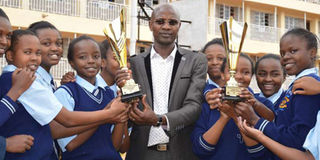Innovations pay off for Physics teacher

Paul Thairu, a teacher at Loreto Kiambu High School who won the inaugural Innovative Teacher on the Year award takes a photo with his students on June 29, 2017. He uses his computer and a projector during lessons. PHOTO | ERIC WANAINA | NATION MEDIA GROUP
What you need to know:
- Previously, Mr Thairu made use of the teacher-centered training model that is still being used by many teachers.
- The teacher took home two trophies (for the national level and central Kenya), a laptop and Sh100,000.
When Paul Thairu, a physics and mathematics teacher at Loreto Kiambu High School went out of his way to make teaching and learning for his students interesting through innovation, his aim was to make his work easy.
Little did he know that his innovations, which he has been advancing every now and again depending on the emerging technologies, would put him in the limelight after he was picked winner of the inaugural Innovative Teacher of the Year Award.
The 36-year-old, who previously taught at Loreto Msongari and Loreto Limuru, landed the prize for having successfully integrated innovation and ICT in his teaching, beating other teachers from academic giants across the country.
LAW OF GRAVITY
Mr Thairu uses locally available materials, which do not cost much, in his work.
He puts them together and uses them to teach his students, mainly to give examples on particular topics, especially complex ones.
The teacher, for instance, came up with videos featuring objects falling, and someone lifting an object from the ground to demonstrate Isaac Newton’s law of gravity.
Mr Thairu also recorded a video and took photos using his smart phone, with his students as the subjects to demonstrate how pressure is higher on a load with a narrow base compared to a wide one.
He uses his computer and a projector during lessons.
ANALOGIES
Mr Thairu recorded two of his students walking on sand, one of them putting on gumboots while the other wearing high-heeled shoes.
The student in gumboots, which have a wide base, walks comfortably while her colleague has difficulties because her shoes keep on sinking in the sand due to high pressure.
“I shoot the videos and take the photos within the school compound. I make sure I have scripts that give the simplest examples on a particular topic for the students to understand,” Mr Thairu said.
He added that he uses his students as the main actors in the videos as the rest of the class can easily identify with them.
LESS EFFECTIVE MODEL
Mr Thairu said he has been using various innovations for more than five years, and has been making improvements on them.
He said the availability of smart phones, affordable laptops and projectors has brought his ideas closer to his students.
Previously, Mr Thairu made use of the teacher-centered training model that is still being used by many teachers.
Under this model, the teacher does most of the work of giving notes and oral explanations on various topics.
This, he said, made his lessons boring because students were reduced to listeners and observers.
PARTICIPATORY MODEL
Communication was one way — from the teacher to the student, and if there was feedback, it was minimal.
Tired of this method, the teacher adopted another strategy — the student-centered training — with the aim of involving the students more in class work.
If the class was discussing a topic, students would do demonstrations on their own, but under his supervision.
For instance, if the work was on the law of gravity, a student would drop an object and then pick it up during the lesson.
This was meant to demonstrate how the law works.
INTEGRATED INNOVATION
Though this approach was, to some extent, effective, Mr Thairu found it not satisfactory because it was like a question-and-answer affair, and so he decided to devise other ways to make his classes interactive.
He ensured all his students became more active.
That is how he came up with the idea of integrating innovation and ICT in his teaching four years ago.
MEMORY
There was no other better way to do it than using simple but highly informative images captured from day-to- day occurrences to demonstrate given concepts.
“I realised that the student-centered training had more potential, and so I integrated it with ICT. The class became more interesting as it was interactive, with students engaging each other more through discussions.
“It became easier to understand the topics because students learn by emulating what they watch in videos and photos. It is also easy to recall what one has watched than what one has read or heard,” he said.
REWARDS
He added that performance improved, and the students became more interested in physics, which most of them used to regard as complex.
Mr Thairu has been encouraging his colleagues to adopt his strategy.
The teacher took home two trophies (for the national level and central Kenya), a laptop and Sh100,000. His employer also promoted him.





